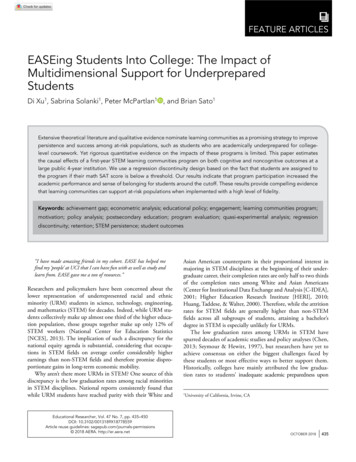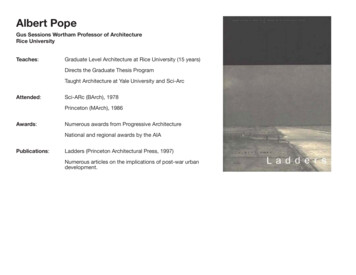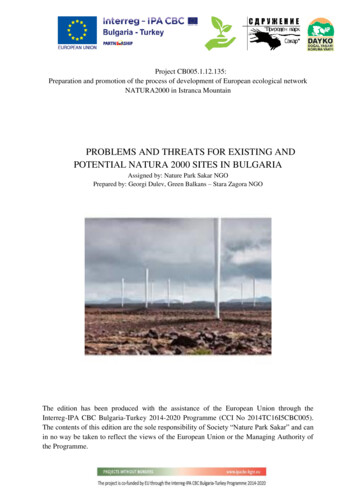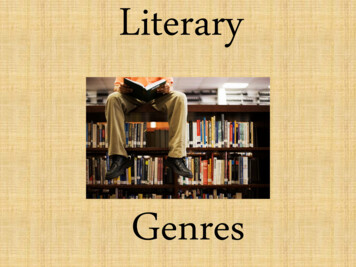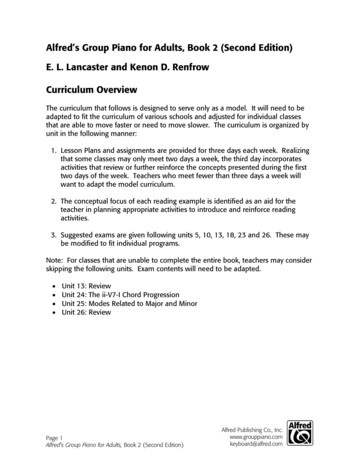
Transcription
Sci-Fi GroupByIndian Association for ScienceFiction Studies(IASFS)1
INDEXSr.NameNo.1.2.Editorial BoardFrom chief editor’s desk3.Gerard Deepak, Pushpa C N,Ayush Kumar, Thriveni J,Venugopal K R4.Dr Kasturi Sinha Ray5.Priyadharshini Krishnan &Akshaya Subramaniam6.Shikha Khandpur7.S. Priya Dharshini, Dr C. G.Sangeetha8.Dr Shantala K R9.Dr Sindhu Janardan10.Dr Swasti Sharma11.Mr. Kailash ankushrao atkare12.Dr Jyothi Venktaesh13.Kavin Molhy P. S, Dr C. G.Sangeetha14.Nabanita Deka15.Dr Navle Balaji Anandrao16.Dr Nidhi Mishra17.Rajani Raveendra18.Shobha M19.Smita PotnisTitleDLKIA: A Deep Neural Network BasedKnowledge Integration Approach forKnowledge Base Generation for ScienceFiction as a DomainAndroids, Surveillance and Evil: AnOverview of Jonathan Nolan’s WestworldRacial Discrimination and ScientificAmelioration in Isaac Asimov’s‘The Weapon too dreadful to use’A Post humanist Reading of Homo Deus: ABrief History of TomorrowFrankenfood: A Cornucopia in PaoloBacigalupi’s The Windup GirlAbnormal Human Beings in HinduMythology and Possible Medical ExplanationBangalore’s Urban Ecology Crises: ScienceFiction to the Rescue?Dystopian Awakening: EcocriticalRumination on Climate Change in Narlikar’s“Ice Age Cometh”Science Fiction, Women and Nature:Ecological PerspectiveCyrano de Bergerac: Father of ScienceFiction Literature in France? A ReflectionDelineation of Optimistic Women in TheCalculating StarsBreaking the Myth: Women as Superheroinesand Supervillains in a Dystopian WorldFemale Characters in Science Fiction:Archetypal Messengers of Social Equity andEqualityExploring the Gamut of African AmericanWomen Science FictionSultana’s Dream and its Conception ofFeminist UtopiaA Journey through ‘The Forbidden Country’:The Representation of Gender in ManjulaPadmanabhan’s The Island of Lost GirlsPortraiture of Women, Robots and RoboticBehaviour in Marathi Science Fiction2Pageno.6789101112131415161718192022232425
20.Anamta Rizvi21.Ebin ThomasNandana K Dr. B M Jayashree(Retd)22.23.Premila Swamy D24.Rani Susmitha25.Gerard Deepak, Ayush Kumar Aand Santhanavijayan A26.Dr. Vaishali K.S27.28.29.30.31.32.33.34.Hemapriyaa S, Aarunya P &Gugah A.Hinduja.M.S., Vijaissri.T &YogeswariS,Pavithra V.SReenaSapna AnandanSarulatha & DeepikaShobia P & Dharani D:Akshaya.E, Divyaa.S. S. &Kaviyasree. S36.37.Charan Kumar K, KamsaliNagarajaDeepa & E. NandhiniDr Shantala38.Gayathri G & Vaishaali B39.Iniya Chinnasamy40.Mitkari S.B.41.Sami Ahmad Khan42.Ms Sayujya Sankar, Ms. ArpithaBhaskar43.Sheetal Balyan44.Sohini Chakraborty35.Indian English Science Fiction: Expanding/Exploding the Canon of Indian Writing inEnglishMary Shelley: The Mother of Science FictionPractical Approach on aspects of Nāṭyaśāstrafor Science FictionIntroducing Science Fiction for Engineeringgraduates in Technical Institutions: Scope andlimitationsIndian Health care delivery-A dream and thedestinyScifiOnto: Modelling, Visualization andEvaluation of Science Fiction Ontologiesbased on Indian ContextualizationChallenging essentialist notions of femininity:feminist science fictionVow against DefloweringMission George and the ZaneBrushing, Coding, FightingQuantum warriorsThe Human MissionTime is UniqueBenevolent communication with AliensWomen’s Space Craft - “Power tends tocorrupt and absolute power corruptsabsolutelyRadon in houses and workplaces as the ghost!HUMROBALIMedical Technology of the FutureThe technology of living immortal based onthe movie “Maayavan”Black Panther Movie African DiasporaThrough Technoculture And Science FictionScience Fiction film ‘Pandemic’ (2016)correlate to the present scenario: A PandemicCOVID-19First Contact, 2070 AD: Mythology andMankind in Bollywood SF FilmsBlack Panther: Afrofuturism and the Politicsof the AnthropoceneIssues of Identity in Star Trek vis a vis Nationand NationalismBollywood and Science Fiction: The Framingof Bollywood’s Superhero 495051
45.Sreedevi.T, Ravi B.K46.Divya M B48.Kamsali Nagaraja, BalakrishnanManikamMeenal R. Kale49.Ruchita Machal50.Sujatha Swamy51.Jyoti B. Mohanty52.Sruthi.S53.Dr Mayanglambam Sarda Deviand Dr Arambam Sophia54.Apurva Renukadas Deshmukh55.Indrani Das Gupta56.Nagaraja ND57.Sheena Lama58.Vishnu Prasad T. R5960.61.62.63.Abhishek Kumar MishraMustafa VohraSahana PrasadSeema KulkarniTanmay Shrivastava64.Usha Devi, Sudha and I. Reena65.Vinita Balasubramanya66.Vishnupriya67.Dr Anand Arul Das68.Abhishek Sharma Padmanabhan69.Lavanya S & Dr V. Sangeetha,70.Priyasha & Gopika Rakesh47.Portrayal of Women in P.Padmarajan’sCinema: With Special Reference ToNovemberinte NashtamContemporary Concerns and Challenges inHigher Education: Some Reflection onHumanitiesDoes Cloud Seeding Increase Rainfall - AFact Or Fiction?Time and Space in Jayant Narlikar’s VirusThe Mythical Twist in Indian SpeculativeFictionSpace Adventures in French LiteratureGame of Thrones: Science Fiction aHistorical FantasyScience Fiction in Education on FutureGenerationsScience Fiction and Scope for FutureTechnologyWhat Is Humanity: A Study of Early NovelsBased on Science Fiction and GeneticEngineering.Simulated World of Trauma: EncounteringViolence in Tarun K. Saint’s Short Story “AVisit to Partition World”Fictions of Literature and LanguagesThe Mutant Metaphor: Smashing Stereotypesor Surrendering to StandardsDystopian City: An Exploration of theFuturistic Chicago in Divergent Trilogyभय बिनु होई न प्रीबिLive together Die togetherWfh.You better be alert!!A Red TrajectoryDifficult BreathsWeird life story of the photon: From fiction torealityAYUSHMAAN BHARAT- Vision for ABetter IndiaStar Survival SquadA Posthumanistic Reading of Isaac Asimov“A Boy’s Best Friend” and “SatisfactionGuaranteed”.The role of Artificial Intelligence (AI) as atool for dissemination of Justice - Issues andChallengesClay’s Ark as a Microbial NarrativeBreakdown of Dystopian Elements in NeonGenesis Evangelion: Analysing 757677
71.Sowmya72.73.Dr ShantalaSapna kattiInteraction between Sci-Fi andPsychoanalytic/Mythopoetic ElementsPhilip K. Dick redefinition of (in) human inthe select novel Do Androids Dream ofElectric Sheep“Cyborg Srinivasa” (ಸ ೈಬಾರ್ಗ್ ಶ್ರೀನಿವಾಸ)Mitra5787980
Editorial BoardSr.No.NameContactRole1.Dr. Srinarhari M. H.doctorhari567@gmail.comAdvisor2.Dr. Anjali Naikanjali.naik360@gmail.comChief Editor3.Dr. Shantalashanyashas@gmail.comEditor4.Dr. Indrani Dasguptagupta.id11@gmail.comEditor5.Ms. Deepa Kamaldeepukamal2628@gmail.comEditor6.Ms. Keerthy Rameshkeerthunatgeo07@gmail.comEditor7.Mrs. Vani Sushrutavanisushruta@gmail.comEditor8.Mr. Vishnu Prasadthevishnuprasadtr@gmail.comEditor9.Dr. Meenal Kalemeenalycce@gmail.comEditor10.Dr. Dayanandh Gangadhardayanandhgangadhar@gmail.comEditor11.Mr. Debraj Moulickdebraj.moulick@gmail.comEditor12.Mr. Prasanna ort6
From Chief Editor’s DeskIt gives me and my team an immense pleasure to present this book of E-abstracts in theInternational Science Fiction Conference-2020.Science Fiction is comparatively a modern genre of literature devoted to scientific writings.It is said to have a social goal of predicting the future. To be precise, it helps in connecting thepresent with the future. Reading science fiction enables us to reflect on the ways people interactwith each other, with technology, with our environment.This conference held is unique in the sense that all the sessions were virtually conducted in acompletely pre-recorded form. All presenters presented their papers in the form of videorecording. In the conference, under 14 sessions devoted to various themes like Authors narratestories, Story Reading, Ecology and Science Fiction, Science Fiction Movies, Science Fictionstories from languages other than English (Kannada and Hindi) etc, very scholarly papers werepresented, which I am sure, the readers will enjoy. In this book, we have presented the abstractsas a glimpse of works presented during the conference. We are all thankful to the organisers ofthe conference to give us the opportunity to edit this E-book. Thanks to all my team of editorsfor their cooperation!Dr. Anjali NaikChief Editor7
IASFS/SF/001Gerard Deepak, Pushpa C N,Ayush Kumar, Thriveni J, Venugopal K RDepartment of Computer Science and EngineeringNational Institute of Technology, TiruchirappalliUVCE, Bangalore UniversityVice Chancellor, Bangalore University, BangaloreArtificial IntelligenceDLKIA: A Deep Neural Network Based Knowledge Integration Approach forKnowledge Base Generation for Science Fiction as a DomainAutomatic Knowledge Base Generation is quite important and is a prerequisite forseveral information systems in the current era where most of the applications are knowledgecentred.The availability of extensive amount of data and the non-availability of knowledgemakes it quite cumbersome for information systems for reasoning and inferencing. KnowledgeRepresentation and Reasoning is quite essential in the era of Symbolic Artificial Intelligenceand Collective Artificial Intelligence. A knowledge integration framework based on aRecursive Deep Neural Network has been proposed to densely populate the Entities in theexisting Science Fiction Ontology based on several heterogenous dynamic knowledge sourcesbased on SPARQL based querying and closed word semantics. Apart from this, an EntityGraph based inferential reasoning scheme has been instilled into the approach.A massive Knowledge Base for Science Fiction as an Independent Domain has beengenerated and a Domain Compliance F-Measure of 97.86% has been achieved for the proposedapproach.8
IASFS/SF/002Dr Kasturi Sinha RayAssistant ProfessorGLA UniversityMathuraArtificial IntelligenceAndroids, Surveillance and Evil: An Overview of Jonathan Nolan’s WestworldThe Nolan brothers- Jonathan and Christopher-are reputed for creating artisticmovies and TV series on original and phenomenal science-fiction ideas.‘Westworld’ (2016-2020), a dystopia produced by HBO in three seasons- TheMaze (2016), The Door (2018) and The New World (2020) is a Jonathan Nolan creation incollaboration with Lisa Joy.This paper discusses surveillance and an affinity for organized evil technologywhich interests humans. With AIs aiding our daily lives, this study attempts to understand thefuture with the androids and surveillance.In the first two seasons guests buy expensive tickets to slaughter, molest, abuse,mutilate and rape the android hosts in a semblance of world minus legal bindings. The parkfetishizes human’s affinity for evil and sells it as ‘freedom from social constructions’,desirable and a quite expensive commodity: unleash your basic instincts. Hundreds of hosts,including animals, manufactured with care and precision, run the show in an amusement parkwith ‘wild west’ theme. Landforms, sheriffs, cowboys to batwing bar doors, shot-gun culture,country folk come to life in a looped storyline. The hosts are monitored, every decisionprogrammed and when they fall, are extracted, and repaired daily.In the final season, an artificial intelligence called the Rehoboam is built topredict terrorist attacks. A giant ball of AI that feeds on data from virtual reality, profileshumans and records their life events via the ubiquitous CCTVs, represents an exaggeratedlevel of surveillance.However, the makers of Rehoboam lose control over the AI and it begins to playGod/ The commodity becomes aware of its value and asserts itself on the producers.Conditioning, re-programming, brainwashing and even killing humans to ensure Rehoboam’spredictions always hold true.9
IASFS/SF/003Priydharshini Krishnan & Akshaya SubramaniamII M.A. English,Department of EnglishSri Sarada College for Women (Autonomous),Salem, Tamil NaduArtificial IntelligenceRacial Discrimination and Scientific Amelioration in Isaac Asimov’s‘The Weapon too dreadful to use’This fine science fiction story can be analyzed in two perspectives.On the one hand, it deals with the plight of the colonized Venusians and their strugglefor autonomous rule and independence from their Earthly exploiters and oppressors. Thismirrors the racial and ethnic dominance in the Universe. Asimov’s descriptions of Venus andits capital city named Aphrodopolis is an early hint at Afrofuturism.On the other hand, it focuses on rapid development in science and space exploration.The description of the dreadful weapon that decerebrates any living creatures bydisconnecting the brain from thinking indicates the degree of advancement of science inneurotechnology.Currently, governments mull about creating mind-controlled weapons that instantlyread soldiers’ minds using tools like genetic engineering, nanotechnology, and infraredbeams. But science today has yet not discovered such a destructive weapon. If we were to doso, it could be either a boon or curse for military and defense and maybe a threat for the world.10
IASFS/SF/004Shikha KhandpurPhD ScholarDepartment of EnglishUniversity of JammuArtificial IntelligenceA Post humanist Reading of Homo Deus: A Brief History of TomorrowThis research paper aims to use the lens of Posthumanism literary theory to analyze thework Homo Deus: A Brief History of Tomorrow written by Yuval Noah Harari.This work of non-fiction mainly discusses the future of mankind; he discusses thenarratives that are currently used to make sense of the world and discusses the future turningtowards transhumanism which brings in the discussion of the relationship between humans andtechnology.This research paper attempts to discuss the timely question of what the future holds forhumans and discusses the journey of humans up to this point and beyond.11
IASFS/SF/005S. Priya Dharshini, Ph. D. Scholar &Dr C. G. SangeethaAssistant Professor of EnglishSri Sarada College for Women,SalemEcology and Science FictionFrankenfood: A Cornucopia in Paolo Bacigalupi’s The Windup GirlGenetic engineering is a process by which DNA or other nucleic acid molecules areartificially manipulated, modified and recombined in order to alter an individual or a populationof organisms. Genetic Engineering plays a major role in the current scenario, especially infocusing on the development of plants and animals, food production, disease detection, medicalcare, vaccines and other useful drugs. There are both pros and cons of genetic engineering.Though genetic engineering is useful in many areas, when it comes to food production andhuman health, it creates fear of having an adverse effect on human beings. The article examinesthe science fiction dystopian novel The Windup Girl with the glimpse of the Cornucopianperspective and highlights the ramifications of Genetically modified food and its adverseeffects on human health.12
IASFS/SF/006Dr. Shantala K.R.MBBS, DGO, (ObGyn)ConsultingBengluruEcology and Science FictionAbnormal Human Beings in Hindu Mythology and Possible Medical ExplanationThe Hindu mythology abounds with many 'beings' who are depicted as even havingsupernatural powers. Of course, The theory of Evolution may never be able to explain them.Yet it is of interest to explore if the current medical concepts & technologies can explainthe various 'abnormal' beings.We have advanced Assisted reproductive techniques like IVF (In Vitro Fertilization,known to public as test tube babies) yet we have yet not developed an artificial womb to growfoetuses. But there are instances in Hindu mythology where babies were grown outside thebody. We pride ourselves today that science has made path breaking discoveries in Genetics.Yet we are not even close to making chimeras (organisms with a combination of species/classes) while the Hindu mythology has so many of them like- Varaha Swamy (man boar),Narasimha Swamy (Lion man) etc!!!Omniscient or omnipotent beings are so common in Hindu Mythology. Could there bea plausible explanation? I have tried to explore and explain if the various ‘abnormal’ lookingcharacters that we come across in Hindu mythology can be attributed to current medicaltechnology. As a doctor and especially an Obstetrician and Gynaecologist, I have beenfascinated with the various mythological characters and how they could be medicallyexplained.13
IASFS/SF/007Dr Sindhu J.,Associate ProfessorDepartment of EnglishBangalore University.Ecology and Science FictionBangalore’s Urban Ecology Crises: Science Fiction to the Rescue?There has been a plethora of cross-genre writing on Bangalore as a city-spacecommenting on its history, its evolution into a cosmopolitan megacity and its consequent urbanecological crises. The writings span across quantitative/qualitative data analysis studies onspecific civic/ecological issues with projections for the future, photo narratives, personalautobiographies and novels. The dominant discourses that arise from these writings are mainlyseen in the showcasing/ nostalgia of an idyllic ecological past, together with urgent data-basedcalls for the addressal of present day civic/ecological crises in the city. Juxtapositions ofBangalore past and present have also played an important role in creating awareness of ecocidalpractices. While the text self-reflexively uses the techniques of dream-sequence and imaginarywish-fulfilment to project the fantasy of a Bangalore with most or all its civic/ecologicalproblems resolved, it remains within the realm of possibility as far as an enlightened scientificvision goes. While locating herself as a citizen within the present-day crises-ridden anddysfunctional urban space of Bangalore, the speaker in the text creates a futuristic Utopian cityspace in which these ecological problems have been miraculously and scientifically solved.The imaginative power of her projected vision is particularly potent in the context of givingthe ecologically impossible a scientific reality. If science fiction may be loosely understood asa way of pointing at future possibilities for human and ecological evolution, I argue that thistext self-reflexively uses many of the elements and tropes of science fiction (in itsmundane/feminist/protest manifestations) and exemplifies a uniquely creative and useful wayforward in the ecological future of Bangalore.14
IASFS/SF/008Dr Swasti SharmaAssistant Professor (ad-hoc), Department of English,Satyawati College,University of Delhi.Ecology and Science FictionDystopian Awakening: Ecocritical Rumination on Climate Change in Narlikar’s “IceAge Cometh”Science fiction is characterised by the pervasiveness of cognitive estrangement.According to Darko Suvin, a science fiction story or novel encompasses ‘novum’, a devicewhose presence compels us to imagine a different way of perceiving our world. Jayant VishnuNarlikar’s oeuvre integrates the function of cosmic epoch and quantum theorisation withtotalitarian or post-apocalyptic weltanschauung. His “Ice Age Cometh” is a ‘fantastic’cautionary tale, narrating a radical departure from the world of complacent experience.Therefore, it is imperative to examine the anticipated ramifications of climate change from anecocentric standpoint.The paper will primarily scrutinize the positioning of existential anxiety in sciencefiction. In addition, the research paper shall attempt to analyse fictional Dr. Chitnis’sapprehensions on equilibrium disruption in the light of IPCC’s (Intergovernmental Panel onClimate Change) warnings. Through comparative analysis, the contrast between Indian andwestern sci-fi will be brought to the fore.Ethnomethodological approach and close-textual analysis will be employed to discernthe criticism of over-industrialisation in the aforementioned short story by Narlikar. Thephenomenon of “spiralling towards ice age” emanates from the blatant negligence andindifference of the “top brass”. In light of this, the paper will concomitantly examine the roleand responsibility of intellectuals using the Gramscian model. By acknowledging the urgencyof scientific literacy in assessing contemporary environmental risks and the biologicalunderpinnings of human consciousness, the paper will place premium on the significance ofinterdisciplinary discursive and information technologies.15
IASFS/SF/009Mr Kailash Ankushrao AtkareAsst. Prof. Dept. of Basic Sciences and Humanities,Marathwada Institute of Technology,Aurangabad.431001Ecology and Science FictionScience Fiction, Women and Nature: Ecological PerspectiveThis research paper aims at establishing the moral connection between science fiction,women and nature. Scholars always discussed the moral link in science fiction, women andnature, whether women envision wealth differently from men. Ecofeminist wrote that womenand nature are linked in ‘morally significant ways. It means the oppressed are in solidarity witheach other. It’s often a cultural myth that women are somehow closer to nature than men.However, being relegated to the realm of nature and caretaking work does give them anunderstanding of the ways in which we are all connected to nature. Women understand ourmaterial dependence on nature and the power of nature. The work women are made to docreates sensitivities and empathy. As a result, women possess moral knowledge, not becauseof being in a female body, but because of what female bodies are made to do. Even if we lookat just these last 200 years, women’s energies have gone towards improving schooling, creatingmovements for equality, creating the entire fields of public health and social work and so on.That makes me say that if women were empowered, they would have created different sorts ofinstitutions and different sorts of wealth. Patriarchy has devalued women. Humanity must riseabove gender discrimination. Ecofeminism is a philosophy of flourishing. Critics say it goesagainst norms of doing commerce and living well. Ecofeminism goes against the growth modelof colonialism and capitalism. Environmental philosophers believe that ecofeminismflourishing against norms of living well, has its own response.16
IASFS/SF/010Dr Jyothi VenkateshChairpersonCentre for Global LanguagesBengaluru City UniversityBengaluruPortraiture of Women in Science Fiction WorksCyrano de Bergerac: Father of Science-Fiction Literature in France? A ReflectionCyrano de Bergerac (1619-1655), French writer and libertine scientist of the 17thcentury France, wrote The Other World or Comical History of the States and Empires of themoon and the sun in line with the True History of the Greek writer Lucien (2nd century), wherethe character travels to the Moon or the Utopia of the humanist philosopher, Thomas More. Aburlesque and fanciful novel, and a precursor of science fiction in France: the narrator-hero, ahuman, travels to the Moon and the Sun. In the course of his discoveries, he has philosophicalconversations with the inhabitants of these distant worlds. On the Sun, during a discussion witha magpie, he discovers a new political and social system, the Republic of Birds. But the textgoes beyond the anecdote; it takes on the appearance of an apology and offers several levels ofreading. The story which distracts the reader by making him travel in a fanciful world draws,through the speech of the magpie, the outlines of an ideal, utopian society, far ahead of its timeand implicitly satirizes the social organization and politics of our world. This paper aims toshow how French literature was inspired by science-fiction, much before the real essence ofthe word was understood. Cyrano de Bergerac, through the description of a utopian societycriticizing the society of his time, shows how the narrator's story entertained the reader whileimagining an ideal society founded on wisdom and happiness but allowing to formulate achallenge to the society of his time. Arthur C. Clarke, an English Science-fiction writer,credited the book with the first description of rocket-powered space flight, and with theinvention of the ramjet- a form of the air breathing jet engine. Cyrano’s The Other World orComical History of the States and Empires of the moon and the Sun can be considered as aprecursor text of science fiction.17
IASFS/SF/011Kavin Molhy P.SM.Phil Research ScholarSri Sarada College for Women (Autonomous)Salem-636016Dr. C. G. SangeethaAssistant ProfessorSri Sarada College for Women (Autonomous)Salem-636016Portraiture of Women in Science Fiction WorksDelineation of Optimistic Women in The Calculating StarsWomen in science fiction novels have been portrayed by unique characterization.Women have been afforded a particular position in society. In this regard, science fiction novelsprovide an opportunity to depict women as committed to their passion and to the cause of thenation. The novel Calculating Stars by Mary Robinette Kowal portrays women like ‘SuperHeroines’ who fulfil their dreams of becoming ‘Lady Astronaut.’ Her story achingly beautiful,highlights the protagonist Elma York who is smart, courageous, flawed, a noble human whoachieves her aim. Women in this novel are dressed in space suits showcasing a stunningconfidence. They show exceptional leadership qualities by overcoming sexual barriers and theycreate an alternative lifestyle. Kowal represented a notable depiction of women who achievedtheir passion. This work seeks to break free from tradition and explore new frontiers. Thescience fictional narratives hav the ability to transcend the boundaries concerned with theportrayal of women in a positive and inspiring way. Kowal foregrounds a magnificentcharacterization of women who are vibrant and driven to make use of their opportunity theyare provided with. This study focuses on the portrayal of women in science fiction novels andseeks to bring out the pragmatic side of women.18
IASFS/SF/012Ms Nabanita DekaAssistant ProfessorDepartment of EnglishMaharaja Agrasen CollegeUniversity of DelhiPortraiture of Women in Science Fiction WorksBreaking the Myth: Women as Superheroines and Supervillains in a Dystopian WorldWhen science fiction established itself as a literary genre in the nineteenth century,women were treated as ‘second-class’ citizens both legally as well as socially (Monk 16). Thisspilled over to the literary world as well for the male science fiction writers accorded womenthe same status of ‘second-class citizens’ in their writings in spite of the genre’s claim to bebold, modern, and revolutionary in its approach. Their writings thus, were androcentric withman as the “main line of evolution, [and] with a female satellite revolving around him as themoon revolves around the earth” (Morgan 3). However, in the contemporary context, in a worlddriven by the powerful forces of irrationalism and bigotry, where sexual subordination is stilla reality, science fiction stories offers a space of ‘alternative reality.’ Science fiction hasenabled writers to “question hegemonic regimes and systems of thought” (Saint xiv). Thepatriarchal society has imposed fixed identities and image of women. For a female writer then,the space of ‘alternative reality’ of science fiction stories, serves as an able heuristic tool toexplore the notions of gynocentric identity. Reconnoitring this idea further, the paper seeks topuncture the conventional idea of a woman vis-à-vis the analysis of the protagonist andantagonist of Laxmi Hariharan’s novel, The Many Lives of Ruby Iyer (2014), who are bothwomen. Furthermore, the paper will expose gender roles as social constructs by examining thecharacter of Ruby as a ‘Shero/Superheroine’. Finally, it will dwell on the socio-political use ofscience and technology vis a vis the alternative methods of reproduction ultimately leading toa dystopian world order.19
IASFS/SF/013Dr Navle Balaji AnandraoAssociate Professor & Head, Dept. of EnglishDeogiri College, AurangabadMaharashtraPortraiture of Women in Science Fiction WorksFemale Characters in Science Fiction: Archetypal Messengers of Social Equity andEqualityHistory of science fiction is a matter of power and politics and not justice. Like otherforms of arts and literature, SF is dominated by ideological hegemony and full of sexual politicsand politics of interpretation. For a long time, SF has been understood as predominantly beinga male centered genre. Owing to its sexual/textual politics, SF by women has somehowremained outside the domain of critical scrutiny. Viewed from women’s point of view, oneunderstands that in spite of the rich contribution of women writers this kind of genre of SF stillsuffers the malady of phallocentric assumptions. However, women have been a part of SF sinceits very beginnings and the seminal proto-SF, Frankenstein, was written by a woman, MaryShelley. But the role of women until recent times was a relatively minor one, barring a fewexceptions. SF in the hands of women has even transcended the shorelines of feminism and SFand fictionalized life not merely form women’s perspective but from a humane perspectivebased on scientific conscience. Women writers have not only subverted the SF form and itsconventions for their own ends, but they have also contributed a specifically female voice to aseemingly male genre. SF reflected in male tradition explores and exploits science as a modeof power, politics, domination, destruction, and violence. Women SF, on the contrary, perceivethe scientific knowledge as the means of reconstructing human society in positive termsregarding constructive change, growth, and all-round development. The space of dominanceand violence of SF by men is replaced by women SF writers with space for harmony, coordination, and humaneness. Betty King (1984:1) rightly describes the condition of a SF bookwith a woman character: “Generally speaking, if a SF book was widely read, it had either nowomen characters or women in only minor or, at best, secondary character roles. If a SF bookhad a woman main character, it was not widely read or, at least, did not remain popular intoour own time.”20
The present paper explores and examines female characters and their roles in a few vitalSF works as archetypal messengers of s
stories, Story Reading, Ecology and Science Fiction, Science Fiction Movies, Science Fiction stories from languages other than English (Kannada and Hindi) etc, very scholarly papers were presented, which I am sure, the readers will enjoy. In this book, we have presented the abstrac
